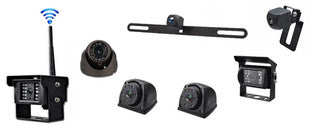Title: Exploring Distinctions Between Wired and Wireless Reverse Cameras for Improved Vehicle Safety
Introduction: In the realm of contemporary automotive technology, reverse cameras have become pivotal for augmenting safety and maneuverability. Two predominant types of reverse cameras dominate the market – wired and wireless systems. This comprehensive guide aims to elucidate the differences between these two alternatives, shedding light on their unique features and advantages.
- Connectivity:
Wired Reverse Camera:
- Relies on physical cables for data transmission.
- Typically involves a hardwired connection between the camera and the display unit.
- Ensures a consistent and stable signal transmission.
Wireless Reverse Camera:
- Utilizes wireless technology, such as Wi-Fi or Bluetooth, for signal transmission.
- Eliminates the need for physical cables, facilitating a neater and more straightforward installation process.
- Offers increased flexibility in camera placement due to the absence of wires.
- Installation Process:
Wired Reverse Camera:
- Requires professional installation due to the necessity for routing and concealing cables.
- Installation process can be more intricate and time-consuming.
Wireless Reverse Camera:
- User-friendly installation, often suitable for do-it-yourself enthusiasts.
- Simplified setup due to the absence of cables, making it quicker and more convenient.
- Signal Stability:
Wired Reverse Camera:
- Generally provides a more stable signal transmission, minimizing the risk of interference.
- Ideal for scenarios where signal consistency is paramount, such as in larger vehicles.
Wireless Reverse Camera:
- Susceptible to potential signal interference, especially in areas with high wireless activity.
- Signal stability may fluctuate depending on the specific wireless technology utilized.
- Range:
Wired Reverse Camera:
- Typically offers a longer transmission range, making it suitable for larger vehicles like RVs and trucks.
Wireless Reverse Camera:
- Constrained by the range of the wireless technology used (e.g., Wi-Fi or Bluetooth).
- May experience signal degradation over longer distances.
- Aesthetics and Cleanliness:
Wired Reverse Camera:
- Cables may necessitate careful routing to maintain a polished and tidy appearance.
- Installation may result in visible wiring within the vehicle.
Wireless Reverse Camera:
- Provides a cleaner aesthetic due to the absence of visible wires.
- Enhances the overall interior look of the vehicle.
Conclusion: Choosing between a wired and wireless reverse camera hinges on your specific needs, preferences, and the type of vehicle you own. While wired systems offer unparalleled stability and range, wireless options provide a trouble-free installation process and a more polished aesthetic. Weigh these factors carefully to make an informed decision aligned with your vehicle safety and convenience requirements.

